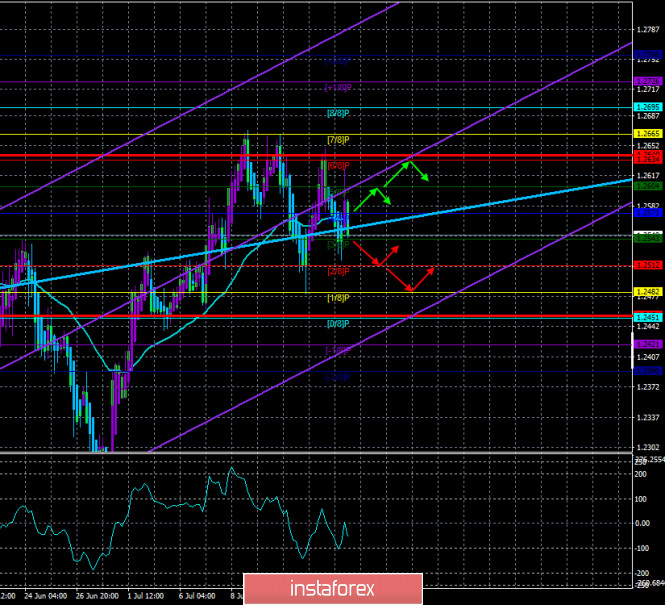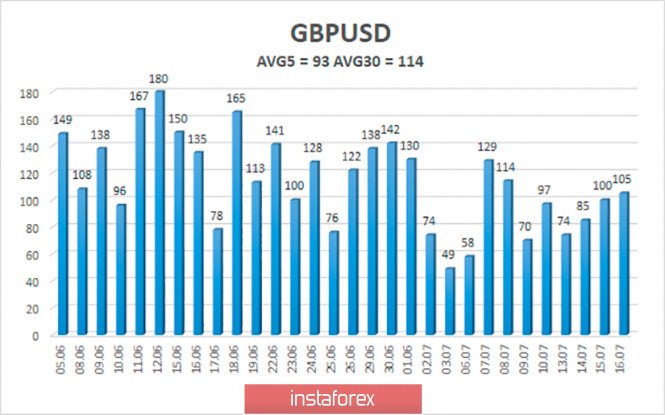
4-hour timeframe

Technical details:
Higher linear regression channel: direction - upward.
Lower linear regression channel: direction - upward.
Moving average (20; smoothed) - sideways.
CCI: -54.4076
The GBP/USD currency pair showed very weak dynamics at the trading on July 16. According to the data on the average volatility of the pair, this indicator has been steadily decreasing recently, which indicates a decrease in the activity of traders. After the quotes reached the level of 1.2665, market participants faced a rather reasonable question: what did the British pound grow on? Yes, we have repeatedly said that the growth of the pound was provoked and justified by the political, social, epidemiological and economic crisis in the United States. And since no pair or instrument can move constantly in the same direction, from time to time there are such movements. However, over the past few years (since 2016, when Brexit began), in most cases, the pound has become more expensive based on expectations, rumors, and traders' hopes for a successful outcome of Brexit. It has been four years and hopes for a successful outcome are no longer necessary. Boris Johnson, who was applauded by the whole of Great Britain at the end of last year, congratulating his party on the defeat of the Labor Party, in almost a year of his premiership and six months of absolute dominance in the country, in fact, achieved nothing. Yes, in 2020, the entire world was hit by the "coronavirus" epidemic (which it was the UK that coped with the greatest losses), but even if you do not take it into account, the country's economy continues to shrink, and its prospects are still dim. To be absolutely honest, any politician could have taken the UK out of the EU the way Johnson did. The main point was to perform the "divorce" with the European Union as "gently" and painlessly as possible for both sides. What has Boris Johnson achieved? It is simply going to sever all ties with the EU and trade with the world on its own terms under new trade agreements. A laudable desire to make the UK as independent as possible from the European Union. However, do not forget that more than 50% of British exports are sent to the EU countries. Thus, a huge number of manufacturers and entrepreneurs will feel the "Brexit by Johnson" very clearly. Moreover, the British Prime Minister clearly still intends to conclude a trade agreement with both the EU and the US. However, who said that Brussels will sooner or later agree to Johnson's demands? As for the United States, in six months the power in this country may change, and Johnson's friend Donald Trump may resign. Thus, the most important thing that all experts and political scientists note now is that the UK does not have a clear plan and strategy for when, with whom and on what terms to conclude trade agreements. And this uncertainty is pressing. It puts pressure on business, it puts pressure on residents, it puts pressure on the currency. After all, it is absolutely clear to everyone that the more damage the UK will suffer as a result of the "coronavirus crisis" and Brexit, the longer the economy will recover. The collapse of the British, of course, does not threaten, but, for example, the prospects of increasing taxes (something to cover the budget deficit) and falling living standards are absolutely real.
Thus, Britain and the US continue to compete now in who is worse off. Britain is still better off only in the issue of the pandemic, which was still managed to put out in the Foggy Albion. We believe that the fundamental growth potential of the British currency has already been exhausted. From the last significant low, the pound rose almost 8 cents. This is quite enough to consider all the negative fundamental background that regularly comes from overseas as fulfilled. Thus, we are waiting for the resumption of the downward movement in the near future. And here you need to be extremely careful and accurate. It should be understood that the fundamental background does not change for a short period of time (for example, an hour or a day). The fundamental background is an abstract concept. More important is not the background itself, but the reaction of traders to it and their interpretation of this background. Thus, we can not say that today the background has changed to negative for the pound. Based on this, we believe that each consolidation of quotes below the moving average line should be considered as having a high potential for the formation of a new downward trend. Moreover, buyers were not able to overcome the Murray level of "7/8"-1.2665 twice and the Murray level of "6/8"-1.2634 once again, forming a certain resistance zone in this area, before overcoming which we would not consider new purchases of the pair at all.
During this week, several important reports have already been released in the UK, two of which clearly upset traders. First, it is GDP for the month of May, which showed much weaker growth than expected. Secondly, this is industrial production for May – the same results. The consumer price index for June against the background of these two reports did not have much significance. Yesterday it became known that the unemployment rate in May did not increase by one tenth of a percent, remaining unchanged at 3.9%. The number of new applications for unemployment benefits in general turned out to be negative - minus 28.1 thousand. However, judging by the reaction of traders, these optimistic data are not too impressive. On the one hand, this may mean that market participants continue to ignore macroeconomic statistics, since previous reports also did not cause a particularly strong reaction. On the other hand, we can assume that these reports are clearly not enough for purchases of the British currency to continue.
At his speech on Thursday, the Chairman of the Bank of England, Andrew Bailey, did not say anything beyond interesting, telling only about the possibilities of creating a national cryptocurrency in the UK. Another performance by Bailey will take place on the last trading day of the week. And this is the most important event for the pound/dollar pair. The head of the British Central Bank may start hinting again at the possible introduction of negative rates. This was previously rumored, and Bailey himself said that the Bank of England is studying this issue, studying the experience of other countries that have resorted to this tool. Thus, if the markets hear new hints about the introduction of negative rates, this could create serious pressure on the pound.

The average volatility of the GBP/USD pair continues to remain stable and is currently 93 points per day. For the pound/dollar pair, this value is "average". On Friday, July 17, thus, we expect movement within the channel, limited by the levels of 1.2454 and 1.2640. A reversal of the Heiken Ashi indicator downwards will indicate a downward movement, and the pair may re-establish itself below the moving average.
Nearest support levels:
S1 – 1.2543
S2 – 1.2512
S3 – 1.2482
Nearest resistance levels:
R1 – 1.2573
R2 – 1.2604
R3 – 1.2634
Trading recommendations:
The GBP/USD pair on the 4-hour timeframe is trading "up-down" near the moving average, then fixing above it, then below. Thus, now there is a kind of flat, and there is no trend as such. Thus, formally, sell orders can be opened when the price is fixed below the moving average line with the goals of 1.2512 and 1.2482. You can buy the pound/dollar pair if it is fixed above the moving average with the goals of 1.2604 and 1.2634.